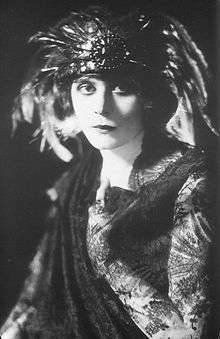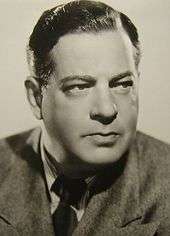The Blue Flame (play)
| The Blue Flame | |
|---|---|
 Poster of Theda Bara in The Blue Flame | |
| Written by | George V. Hobart and John Willard |
| Date premiered | March 20, 1920 |
| Place premiered | Shubert Theatre |
| Original language | English |
| Genre | Science fiction, Thriller |
The Blue Flame is a play written by George V. Hobart and John Willard. Producer Albert H. Woods staged it on Broadway in 1920 in a production starring movie actress Theda Bara. The main character is a religious young woman who dies and is revived as a soulless femme fatale. Bara's movie fame was considered the primary driver of audience attendance at what critics described as a terrible play. It was her last Broadway role and one of her last professional acting projects.
Plot
Atheist scientist John Varnum has developed a way to bring the dead back to life, which he uses when his sweet, religious fiancee Ruth is killed. The audience sees her soul visibly leave her body as the "blue flame" of the title.[1] Varnum revives her, but with no soul she has an entirely different personality. She seduces a young man named Larry Winston and turns him into a cocaine addict. She murders Ned Maddox and frames another man for it. In the final act, Ruth's death and revival is revealed to be a dream John Varnum was having. Upon waking he now understands the importance of the soul; he embraces religion and destroys his life restoration device.
History
Woods gave Bara a lucrative contract. Each week she received a salary of $1500 (about $100,000 in 2015 dollars),[notes 1] plus half the week's net profits. She also got a finely appointed private rail car to take her from city to city when the show toured.[2][3] Woods brought in two directors, J. C. Huffman and W. H. Gilmore, to assist with the production.[4]
While the show was still in previews, writer Owen Davis claimed the story had been lifted from his earlier play Lola, which had appeared briefly on Broadway in 1911, then was adapted as a movie in 1914.[5] He filed a lawsuit, but by the end of May it was settled with a cash payment to Davis.[6]
The tour closed on January 1, 1921.[3] Bara's stage career largely closed with it. She did a season of vaudeville touring, but did not act in it; instead she talked with audiences and told stories about her career.[7] Her only subsequent stage acting was in a Little Theatre production of Bella Donna in 1934.[8] Her film career was also waning. She acted in on only one feature film after The Blue Flame ended, the 1925 drama The Unchastened Woman.[9]
Productions
The play began with a series of preview performances in February 1920, appearing in Pittsburgh, Pennsylvania; Washington, D.C.; Stamford, Connecticut; and Chicago, Illinois. The final performances before the Broadway premier were in Boston in early March.[10]
The show opened on Broadway at the Shubert Theatre on March 15, 1920. It had a run of 48 performances and closed in late April.[11][12]
Cast and characters


The characters and cast from the Broadway production are given below:
| Character | Broadway cast |
|---|---|
| John Varnum | Alan Dinehart |
| Ah Foo | Jack Gibson |
| Ruth Gordon | Theda Bara |
| Barnes | Joseph Buckley |
| Cicely Varnum | Helen Curry |
| Larry Winston | Donald Gallaher |
| Quong Toy | Henry Herbert |
| Ned Maddox | Kenneth Hill |
| The Stranger | Earl House |
| Patterson | Frank Hughes |
| Inspector Ryan | DeWitt C. Jennings |
| Nora Macree | Tessie Lawrence |
| Clarissa Archibald | Thais Lawton |
| Wung Ming | Robert Lee |
| Grogan | Martin Malloy |
| Tom Dorgan | Harry Minturn |
| Miller | Tom O'Hara |
| Ling Foo | Royal Stout |
Reception
Critical reception
The play received overwhelmingly negative reviews. Biographer Eve Golden described the reviews of Bara's acting as "nothing less than vicious", but said they were "like love letters compared to what critics unleashed" on the play as a whole. Variety said there was "no division of daily press opinion" on how bad the play was.[13] The theater critic for Munsey's Magazine quoted several negative reviews and compared Bara's acting unfavorably to that of drama school students.
In The New York Times, Alexander Woollcott mocked the dialog, which included lines such as, "Have you brought the cocaine?" and "You make my heart laugh and I feel like a woman of the streets." Delivered seriously, such lines drew laughter from the audience. Woollcott highlighted one particular line: "I'm going to be so bad, I'll be remembered always." He said Bara was bad, but not bad enough to be memorable. He credited her for having a clear voice, and for not losing her composure when the audience laughed at her.[14] Other reviewers gave Bara similarly faint praise. She had "average competence" or "was not so bad". Some complimented her looks or her glamorous wardrobe.
Other reviewers were less kind. The Brooklyn Daily Eagle said she "made good" on the promise to be unforgettably bad, calling her acting "freakish".[15] The Sun and New York Herald called Bara "a sad disappointment" and the play "abysmal in intelligence and all that touches the art of the theatre".[1]
Historians and critics looking back on the play have affirmed the negative assessment. Biographer Ronald Genini called the play "painfully bad"[16] and described the reviews as "a panning orgy".[17] Theater historian Ward Morehouse described it as "one of the worst plays ever written".[18] Literary critic Edward Wagenknecht said Bara's participation was a "cruel coupe de grace" for her acting career.[19] Golden wondered "what could have possessed [Bara] to appear in this play", speculating that only "a combination of desperation and incredibly poor judgement" could justify her participation.[20]
Box office
Financially the play was a tremendous success. The previews broke attendance records.[4] In Boston the show was sold out, even after adding extra matinees. Despite the strongly negative reviews, the first week on Broadway took in nearly $20,000, close to the maximum the Shubert Theatre could generate at normal prices.[21] It continued to pack the theater for two months before heading back to the road, averaging $15,000 per week.
Notes
- ↑ United States nominal Gross Domestic Product per capita figures follow the Measuring Worth series supplied in Johnston, Louis; Williamson, Samuel H. (2016). "What Was the U.S. GDP Then?". MeasuringWorth. Retrieved April 10, 2016. These figures follow the figures as of 2015.
References
- 1 2 "Miss Bara Fails; The Blue Flame Lacks in Thrills". The Sun and The New York Herald. 87 (198). March 16, 1920. p. 9 – via Newspapers.com.

- ↑ Genini 2012, p. 83
- 1 2 Golden 1996, p. 209
- 1 2 Golden 1996, p. 205
- ↑ "Davis Claims Right to The Blue Flame". The New York Times. 69 (22,694). March 13, 1920. p. 12.
- ↑ "Settle Davis Suit". Variety. 59 (1). May 28, 1920. p. 17.
- ↑ Golden 1996, p. 210
- ↑ Golden 1996, p. 225
- ↑ Golden 1996, pp. 213–218
- ↑ Golden 1996, pp. 205–206
- ↑ Golden 1996, pp. 206, 209
- ↑ "The Blue Flame". Internet Broadway Database. Retrieved February 25, 2015.
- ↑ "Broadway Has No New Shows Coming for Next Fortnight". Variety. 58 (4). March 19, 1920. p. 13.
- ↑ Woollcott 1920, p. 18
- ↑ "Theda Bara Star of Queer Drama". Brooklyn Daily Eagle. 80 (75). March 16, 1920. p. 1.6 – via Newspapers.com.

- ↑ Genini 2012, p. 82
- ↑ Genini 2012, p. 85
- ↑ Morehouse 1949, p. 175
- ↑ Wagenknecht 2014, p. 130
- ↑ Golden 1996, p. 204
- ↑ "Theda Bara Does $20,000". The New York Clipper. 68 (7). March 24, 1920. p. 4.
Works cited
- Genini, Ronald (2012) [1996]. Theda Bara: A Biography of the Silent Screen Vamp, with a Filmography. Jefferson, North Carolina: McFarland. ISBN 978-0-7864-6918-5. OCLC 781129383.
- Golden, Eve (1996). Vamp: The Rise and Fall of Theda Bara. Vestal, New York: Emprise. ISBN 1-887322-00-0. OCLC 34575681.
- Morehouse, Ward (1949). Matinee Tomorrow: Fifty Years of Our Theater. New York: Whittlesey House. p. 175.
- Wagenknecht, Edward (2014). The Movies in the Age of Innocence (3rd ed.). Jefferson, North Carolina: McFarland. ISBN 978-0-7864-9462-0.
- Woollcott, Alexander (March 16, 1920). "The Play: The Blue Flame". The New York Times. 69 (22,697). p. 18.